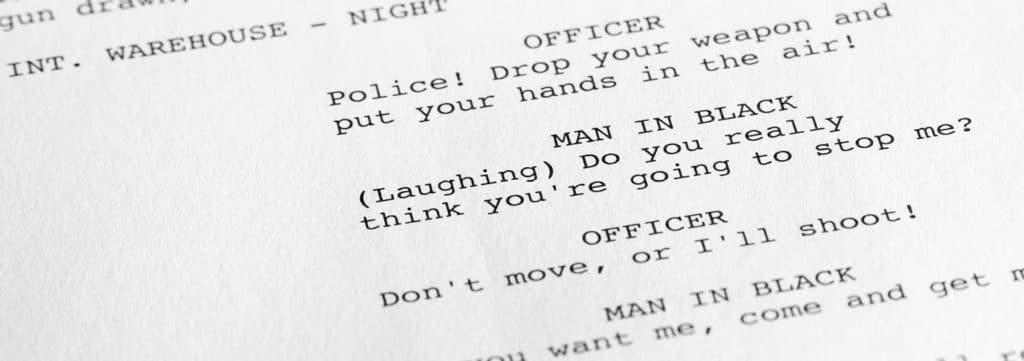
Short films are a great place for any aspiring screenwriter or filmmaker to start. Plus, it’s a fantastic way to make your first mark within the industry.
Short films are everywhere. You may have seen pages of short films on video streaming sites like YouTube and Vimeo. Or you’ve seen a big studio like Pixar play a short before their blockbusters at the movie theatre.
Of course, there any many kinds of short films we can create; it’s up to you to choose the right one to tell your story.

Table of Contents
- Why Write a Short Film?
- How Long Does My Short Film Script Need to Be?
- 9 Tips for Writing a Short Film
- How Do I Structure My Scenes?
- I’ve Written the Script, What Now?
- Conclusion
Why Write a Short Film?
But why would you want to write a short film? Well, they can catapult you into the industry, giving you ample opportunity to show off your skills in writing, directing, or producing (or all three!).
‘Couldn’t I write a feature film?’ we hear you ask. Yes, of course, you could, but there are more similarities between the two than you might think.
Paul Lucey used the phrase “Good things come in small packages”, perfect to apply to short films. We can compare any feature film that’s live-action to a short film. A short is a feature condensed down. The essence of the story and the character arcs are identical.
So if you are just starting out, we recommend writing a short film to get your work noticed. A calling card for the wider film world!
Don’t forget that filmmaking is expensive. Creating and distributing a short film is manageable for most aspiring filmmakers. You can do this all yourself as well as fundraising from outside sources.
This not only gets your foot in the door but allows you to connect with other like-minded filmmakers. Plus, managers and agents have an easy-to-digest vision of your voice and talent.
How Long Does my Short Film Script Need To Be?
Short films are generally 1 to 30 minutes in length. Any longer than that and you are creeping into TV pilot territory. You may need to re-think the best way to tell your story. Remember that 1 page of script is equal to roughly 1 page of screen time.
It is plausible to write a micro-film of under 5 minutes. You can include all the conflict, character, and world-building to engage audiences.
Or you could opt for a film anywhere between 5 and 30 minutes. The choice is really yours.
For a full rundown of how long scripts of different types should be, check out our complete guide here!
Write Your Script with Hollywood Standard Format with the Celtx Script Editor (It’s FREE)

9 Tips for Writing a Short Film
| 1. Have a Compelling Story |
| 2. Have Relatable & Complex Characters |
| 3. Write a Synopsis |
| 4. Write Your First Draft |
| 5. Read as Many Short Film Scripts As You Can |
| 6. Ensure All Your Scenes Have 3 Key Elements |
| 7. Start on Page One |
| 8. Enter Late and Leave Early. |
| 9. Use Correct Formatting |
1. Have a Compelling Story
Story is king. You must have a gripping story that will keep your audience engaged.
When you develop a story, it must have an emotional impact on an audience. If not, it may be a story not worth telling.
Stuck for ideas? There are many techniques you can use for ideation. Try using your own life experiences or turn something pre-existing on its head.
2. Have Relatable & Complex Characters
Andrew Horton said, “strong characters hold our interest in life and on the screen”. It’s true that we form bonds with people we relate to in our daily lives. Well, it’s exactly the same in the movies.
As screenwriters, we need to create vivid and active characters. Our protagonists must have a driving want and need. Plot points then challenge these wants and needs. We create conflict and obstacles for our characters to overcome.
These struggles give us the heart of the story.
3. Write a Synopsis
Before you begin, you should have a clear outline of your story. You should know the plot inside out, your characters’ motivations and how they will develop.
TIP: Keep your story simple with few characters and locations. Avoid many plot twists and complex points of view. You always want your film to have the biggest impact on your audience as possible.
You could also write a beat sheet outlining the plot of the film. Whichever process you choose, you need a clear synopsis before writing the script.
From there, write out a treatment. This is an in-depth version of your outline. You can include further world-building, snippets of planned dialogue and expansions of scenes.
Once you have done this, writing the script will become a lot easier.
4. Write Your First Draft
Using your outline and treatment as a reference, begin writing the script. By referring to your treatment, you continue fleshing out scenes and dialogue. All in the format of a screenplay.
All screenwriting software will format the script as you write. This means you can focus on what’s important: the story and the characters. Smart, right?
And remember, this will be your first draft! No writer’s first draft is perfect so expect to rewrite and edit the script. There’s no set number of times you’ll need to do this. Keep going until you are 100% happy.
How Do I Structure My Scenes?
Yes, all screenwriting software will format the script for you. But it is useful to know how screenwriters structure scenes. Before you try writing a scene for yourself:
5. Read as Many Short Film Scripts As You Can
Free screenplays are available online through various databases. Here are a few of our favorites:
6. Ensure All Your Scenes Have 3 Key Elements.
All the scenes you have planned in your outline may be fantastic in their own right. But some scenes are more important than others. Tal Mcthenia writes that all scenes should have:
- Relevance (must be vital to the plot)
- Conflict (obstacles preventing the protagonist from achieving their goal)
- Structure (a beginning, middle and end)
If any of your scenes do not drive the story, have conflict, or tell us something about a character, they need to go. In any film, the story must be concise and impactful.
7. Start on Page One.
A short film is exactly that. It’s short. There is little time for lots of set up. So, choose your exposition wisely. What is going to be key to the story arc and character development?
Your inciting incident should occur on page one of your short film script. Then your audience knows what the protagonist is up against. They become immediately invested.
8. Enter Late and Leave Early
Every scene must have a purpose. A moment of change should occur in the plot, thrusting the protagonist into the next scene. Then the cycle continues.
To do this, enter a scene at the point a scene becomes relevant. This is at the beginning of the change moment. Tal Mcthenia refers to: “when the conflict is brewing on the horizon”.
Leave the scene at the time the change moment ends or when the conflict is resolved. This keeps your plot moving.
9. Use Correct Formatting
Yes, screenwriting software can format your script for you. They’re almost like a short film template. Yet, it’s crucial that you can self-format your scripts and be aware of industry standards.
- Scene Headings
In a screenplay, all scenes begin with a scene heading or “slugline”. This tells the reader the location in which the action is occurring. A scene can either be internal (INT.) or external (EXT.). This is then followed by the location and time of day:
INT. WAREHOUSE – NIGHT
- Scene Descriptions
This is a short, sharp overview of the visuals on screen. Remember to be sparing with your description. A screenplay is very different to a piece of prose.
A bustling hallway. Dented lockers and peeling paint.
- Action
Then you’d include the action that the audience will see.
HARVEY pushes and shoves through the crowd of chattering STUDENTS.
Notice the capitalization of “Harvey” and the “students”. When introducing characters for the first time, capitalization makes it clear when someone new is appearing on screen.
- Dialogue
When you have set up the scene with description and action, your characters should then speak. Of course, your characters don’t have to speak straight away. You could also go for a dialogue-free scene if you’re focusing on visual storytelling.
If you are including dialogue, set it out by including the character name first. Speech then follows underneath.
HARVEY
Move it!
Notice how the script has been automatically formatted into the different elements.
All screenplays are conventionally written in Courier New, 12-point font.
Turn your short film idea into a script you can share.
Start writing with Celtx today
I’ve Written the Script, What Now?
Rewrite. Seek feedback from fellow screenwriters, a trusted family member or a friend. Craft a ‘logline’ for your idea and pitch it. Gauge reactions and edit your script accordingly.
To begin with, you may focus on the story and characters. You’ll fix plot holes and realign character arcs. Later, you’ll fix small formatting issues, spelling and grammar. Keep fine-tuning.
Once you have perfected your script, you can:
Enter Your Script into Competitions and Festivals.
Create profiles on Coverfly and Film Freeway to make submissions. Pick competitions and festivals that best suit your script. In short, do your research!
Connect with Fellow Filmmakers.
In the industry, everything starts with building a relationship. No one will want to work with you without knowing you first. Network and connect as much as you can. Social media is a great first step!
Help other filmmakers as much as you can. They’ll be more likely to help you in return. Plus, you’ll gain experience!
Submit your Script to a Manager or Agent.
If you’re looking for an agent or a manager to promote your work, your short film script can help you on your way.
Many agents and managers won’t accept unsolicited script submissions. Through networking, link with directors/producers who can vouch for your script’s potential. One thing you’ll want to be sure you have is a portfolio of your work. Learn how to build one and what it should include here.

Apply for an Internship.
Gain experience by applying to film and TV internships. Use your short film script to show off your skills!
Keep Writing
Don’t stop with one script, build a portfolio. That next idea could be a winner!
Experiment with different genres and hone your skills. You’ll become a better and more confident writer.
Conclusion
Writing a short film is all about focus, creativity, and making every scene count. With the rich approach — and the right tools, of course — you can tell a powerful story in just a few pages. Whether it’s your first script or your fiftieth, staying organized and intentional will help your vision shine on screen.
Ready to turn those tips into action? Celtx gives you everything you need to format, organize, and bring your short film to life. Start your free trial now.
Up Next:

What Makes a Good Short Film? (And How to Make it Great)
Now that you know how to write a short film, it’s time to take the next step: making it amazing! This guide will give you 7 helpful tips to turn your script from good to great.

